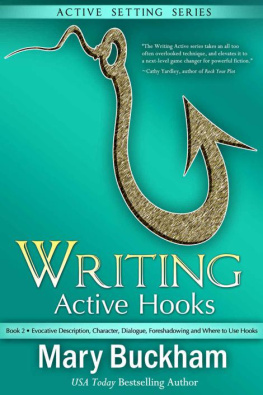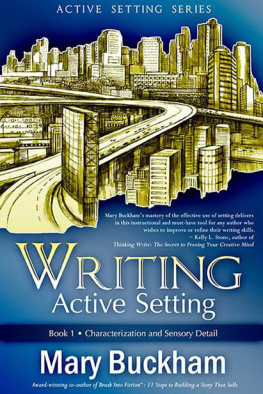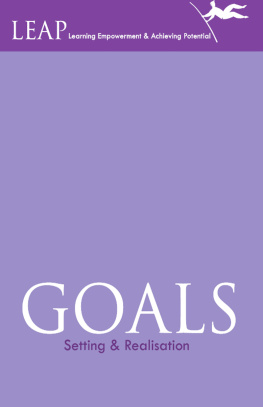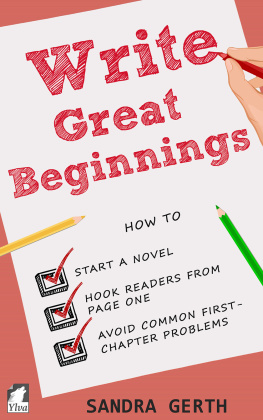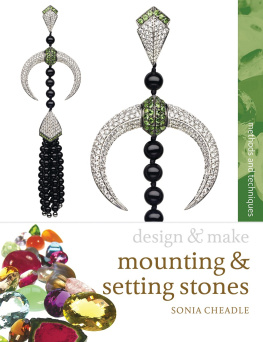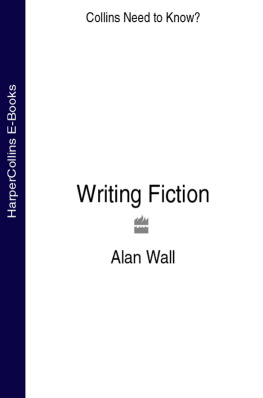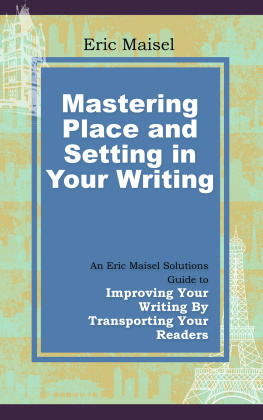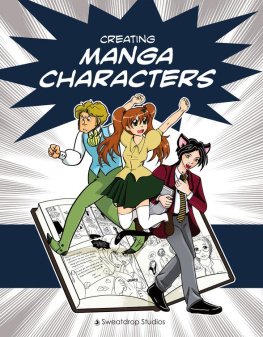
WRITING ACTIVE SETTING
BOOK 2: EMOTION, CONFLICT AND BACK STORY
Content copyright 2013 by Mary Arsenault Buckham.
All rights reserved.
First Edition
No part of this book may be reproduced or utilized in any form or by any means, electronic or mechanical, including photocopying, recording, or by any information storage and retrieval system without permission in writing from the publisher.
Published by
Cantwell Publishing LLC
2675 Wilson Street
Port Townsend, WA 98368
USA
ISBN: 978-1-939210-01-2
Interior and Cover Design by
The Killion Group
www.thekilliongroupinc.com
ACKNOWLEDGEMENTS
Writing any book does not happen in a vacuum, especially a How-To craft book. Id like to thank the hundreds and hundreds of writing students who helped define the assignments and the need to explore how to better use Setting in our novels. Id also like to thank my early readers, all writers who gave invaluable feedback on the format and content of this book: Elizabeth Gibson, Theresa Rogers, Ellen Russell, and Laurel Wilczek. A special thank you to Dr. Patrick Maher, former Chair of the Australian Writers Guild, for his invaluable insights. Any of the great advice I did not take was my fault alone. A special thanks to those writers who read the first book in this series: WRITING ACTIVE SETTING : Book 1 Characterization and Sensory Detail, and who took the time to post a review or inspired writing friends to grab a copy of that book. You rock! A special shout out to Laurie Schnebly Campbell, co-founder with me of www.WriterUniv.com and a whiz with back cover blurbs. Kimberly Killion and her able assistant Jennifer Jakes of HOT DAMN Designs who really know how to design a killer cover and make the process painless. And to my husband, Jim Buckham, who makes all things possible in my world. And last, but not least, thanks to all writers and my readers. Without you, Id have no craft to teach.
Thank you!
Dedicated to the writers everywhere who constantly work to expand their understanding of the craft of writing!
Note to Readers:
Every effort has been made to cleanly edit the book. However, typos do slip in. If you find an error in the text, please email: so the issue can be corrected. I appreciate you as a reader and want to make sure you enjoy the reading and learning process.
Thank you!
Table of Contents
Overview
Introduction
Using Concrete Descriptions
Foreshadowing
Reinforcing Story Themes
Assignment
Recap
Internal/Emotional Conflict
Orientation and Conflict
Conflict Via Contrast
Assignment
Recap
Defining Back Story
Using Contrast
Tying It All Together
Assignment
Recap
Wrap Up
Bibliography
What Folks Are Saying About the Active Setting Series
WRITING ACTIVE SETTING
BOOK 2: EMOTION, CONFLICT, AND BACK STORY
OVERVIEW
In strong writing there is always an overlap of craft techniques and therefore more integration of the whole. Nothing lives in isolation. For those who have read Writing Active Setting: Book 1: Characterization and Sensory Details, you will notice that Emotion as explained in this book enhances what you learned about Characterization in Book 1. This is necessary both for combining the elements into a seamless unit and for helping you assimilate by repetition.
Were looking at very different examples in this book, so you dont need to read Book 1 to understand and embrace the concepts here, but these concepts build on one another as blocks laid one on another create a strong structure. The more you learn about writing Active Setting, the more you will be able to add depth and texture to your writing as you explore opportunities to use the material.
Part 1:
USING SETTING TO SHOW EMOTION
INTRODUCTION
Setting to show emotion is one of the most powerful, although underused by newer writers, tools of Active Setting.
Most readers consciously or subconsciously read for the emotion of your story. They look to the cover to clue them into whether a story is humorous, light, dark, edgy, etc. Within a story though, emotions can run the gamut from light (happy, relief, joy) to dark (anger, fear, terror) as you lead your characters, and thus the reader, on your story journey. Theres enormous energy created on the page by consciously choosing words to ratchet up the emotions you want the reader to experience as your characters move through your story.
Lets jump right in and explore how some amazing authors, writing in a variety of genres, use Setting to show emotion.
Outside, the wind was howling and another line of black clouds was trooping over the city. Big slabs of bruise-colored clouds . The Coffin Dancer Jeffery Deaver
In the above example, Deaver, a suspense/thriller writer, uses weather to clue the reader into the tone of the story by foreshadowing that things are not only bad but looking as if they are going to be getting worse. Weather in Setting, along with specific word choices to describe that weather, is one of the easiest ways to orient the reader to the mood of a scene.
What would have happened if Deaver had not been as meticulous in his word choices?
Outside, the wind blew and another line of clouds was moving over the city. Big clouds.
Any emotion? No. We see clouds, but the seeing of those clouds does not enhance the emotion of the story in any way. Look to the descriptive words being used as many writers depend only on their adjectives. Instead consider powering up your verb choices to get more emotion into a Setting description as opposed to simply relying on your adjectives. Clouds hunkering over the horizon are a stronger image than big clouds on the horizon or fluffy clouds on the horizon.
NOTE : Settings, used well, help pull out the emotions you want the reader to experience on the page.
Lets look at another example of Setting, with and without emotion.
I stood staring out the sliding glass doors. The backyard looked melancholy in the late autumn, the foliage thinned out and the high fence depressingly obvious. The gray pool cover was spotted with puddles of rainwater. The warm colors of the big room were more pleasant, and I roamed around it picking up odds and ends as I stretched chilled muscles. Shakespeares Champion Charlaine Harris
In the above example the initial mood shown by examining the Setting outside the sliding glass doors reflects the emotional tenor of the POV character in this scene. Pensive. Melancholy. Depressed. Later in this passage the author changes the tone by having the character become more active. Warm. Pleasant. Because of these few Setting sentences the reader is prepped for some change in the story from low-key and somber to the feeling of safety within the room. This mirrors what is being set up in the story because within a page danger will approach the house from outside, an outside Setting the reader is already aware of and already knows is dark.
What would have happened if Charlaine Harris had written:
I stood looking out the sliding glass doors at the backyard. The autumn trees looked bare, showing the fence in back. The pool cover was covered with water. The warm colors of the big room were more pleasant, and I roamed around it picking up odds and ends as I stretched chilled muscles.
See? The reader gets a visual of the backyard but no sense of emotion. Theres no contrast between whats happening outside and where the character is inside.
Setting can do so much to set the mood or theme of a story emotionally which in turn makes it easier for the reader to accept what is unfolding or about to unfold. Have you ever read a story, or a scene in a story, thats meant to be suspenseful or frightening or relaxing but the only information you received was a bald comment on the POV characters emotions, or worse, no cues at all of the emotional tenor of the story? Most published stories avoid this speed bump but many unpublished writers assume telling the reader the character is scared or relaxed is enough. Its not.
Next page

